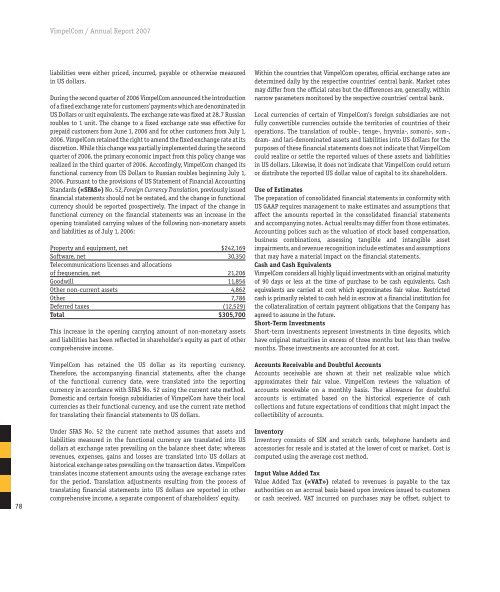Download 2007 Annual Report in PDF (4.8Mb - VimpelCom
Download 2007 Annual Report in PDF (4.8Mb - VimpelCom
Download 2007 Annual Report in PDF (4.8Mb - VimpelCom
You also want an ePaper? Increase the reach of your titles
YUMPU automatically turns print PDFs into web optimized ePapers that Google loves.
78<br />
<strong>VimpelCom</strong> / <strong>Annual</strong> <strong>Report</strong> <strong>2007</strong><br />
liabilities were either priced, <strong>in</strong>curred, payable or otherwise measured<br />
<strong>in</strong> US dollars.<br />
Dur<strong>in</strong>g the second quarter of 2006 <strong>VimpelCom</strong> announced the <strong>in</strong>troduction<br />
of a fixed exchange rate for customers’ payments which are denom<strong>in</strong>ated <strong>in</strong><br />
US Dollars or unit equivalents. The exchange rate was fixed at 28.7 Russian<br />
roubles to 1 unit. The change to a fixed exchange rate was effective for<br />
prepaid customers from June 1, 2006 and for other customers from July 1,<br />
2006. <strong>VimpelCom</strong> reta<strong>in</strong>ed the right to amend the fixed exchange rate at its<br />
discretion. While this change was partially implemented dur<strong>in</strong>g the second<br />
quarter of 2006, the primary economic impact from this policy change was<br />
realized <strong>in</strong> the third quarter of 2006. Accord<strong>in</strong>gly, <strong>VimpelCom</strong> changed its<br />
functional currency from US Dollars to Russian roubles beg<strong>in</strong>n<strong>in</strong>g July 1,<br />
2006. Pursuant to the provisions of US Statement of F<strong>in</strong>ancial Account<strong>in</strong>g<br />
Standards («SFAS») No. 52, Foreign Currency Translation, previously issued<br />
f<strong>in</strong>ancial statements should not be restated, and the change <strong>in</strong> functional<br />
currency should be reported prospectively. The impact of the change <strong>in</strong><br />
functional currency on the f<strong>in</strong>ancial statements was an <strong>in</strong>crease <strong>in</strong> the<br />
open<strong>in</strong>g translated carry<strong>in</strong>g values of the follow<strong>in</strong>g non-monetary assets<br />
and liabilities as of July 1, 2006:<br />
Property and equipment, net $242,169<br />
Software, net 30,350<br />
Telecommunications licenses and allocations<br />
of frequencies, net 21,206<br />
Goodwill 11,856<br />
Other non-current assets 4,862<br />
Other 7,786<br />
Deferred taxes (12,529)<br />
Total $305,700<br />
This <strong>in</strong>crease <strong>in</strong> the open<strong>in</strong>g carry<strong>in</strong>g amount of non-monetary assets<br />
and liabilities has been reflected <strong>in</strong> shareholder’s equity as part of other<br />
comprehensive <strong>in</strong>come.<br />
<strong>VimpelCom</strong> has reta<strong>in</strong>ed the US dollar as its report<strong>in</strong>g currency.<br />
Therefore, the accompany<strong>in</strong>g f<strong>in</strong>ancial statements, after the change<br />
of the functional currency date, were translated <strong>in</strong>to the report<strong>in</strong>g<br />
currency <strong>in</strong> accordance with SFAS No. 52 us<strong>in</strong>g the current rate method.<br />
Domestic and certa<strong>in</strong> foreign subsidiaries of <strong>VimpelCom</strong> have their local<br />
currencies as their functional currency, and use the current rate method<br />
for translat<strong>in</strong>g their f<strong>in</strong>ancial statements to US dollars.<br />
Under SFAS No. 52 the current rate method assumes that assets and<br />
liabilities measured <strong>in</strong> the functional currency are translated <strong>in</strong>to US<br />
dollars at exchange rates prevail<strong>in</strong>g on the balance sheet date; whereas<br />
revenues, expenses, ga<strong>in</strong>s and losses are translated <strong>in</strong>to US dollars at<br />
historical exchange rates prevail<strong>in</strong>g on the transaction dates. <strong>VimpelCom</strong><br />
translates <strong>in</strong>come statement amounts us<strong>in</strong>g the average exchange rates<br />
for the period. Translation adjustments result<strong>in</strong>g from the process of<br />
translat<strong>in</strong>g f<strong>in</strong>ancial statements <strong>in</strong>to US dollars are reported <strong>in</strong> other<br />
comprehensive <strong>in</strong>come, a separate component of shareholders’ equity.<br />
With<strong>in</strong> the countries that <strong>VimpelCom</strong> operates, official exchange rates are<br />
determ<strong>in</strong>ed daily by the respective countries’ central bank. Market rates<br />
may differ from the official rates but the differences are, generally, with<strong>in</strong><br />
narrow parameters monitored by the respective countries’ central bank.<br />
Local currencies of certa<strong>in</strong> of <strong>VimpelCom</strong>’s foreign subsidiaries are not<br />
fully convertible currencies outside the territories of countries of their<br />
operations. The translation of rouble-, tenge-, hryvnia-, somoni-, som-,<br />
dram- and lari-denom<strong>in</strong>ated assets and liabilities <strong>in</strong>to US dollars for the<br />
purposes of these f<strong>in</strong>ancial statements does not <strong>in</strong>dicate that <strong>VimpelCom</strong><br />
could realize or settle the reported values of these assets and liabilities<br />
<strong>in</strong> US dollars. Likewise, it does not <strong>in</strong>dicate that <strong>VimpelCom</strong> could return<br />
or distribute the reported US dollar value of capital to its shareholders.<br />
Use of Estimates<br />
The preparation of consolidated f<strong>in</strong>ancial statements <strong>in</strong> conformity with<br />
US GAAP requires management to make estimates and assumptions that<br />
affect the amounts reported <strong>in</strong> the consolidated f<strong>in</strong>ancial statements<br />
and accompany<strong>in</strong>g notes. Actual results may differ from those estimates.<br />
Account<strong>in</strong>g polices such as the valuation of stock based compensation,<br />
bus<strong>in</strong>ess comb<strong>in</strong>ations, assess<strong>in</strong>g tangible and <strong>in</strong>tangible asset<br />
impairments, and revenue recognition <strong>in</strong>clude estimates and assumptions<br />
that may have a material impact on the f<strong>in</strong>ancial statements.<br />
Cash and Cash Equivalents<br />
<strong>VimpelCom</strong> considers all highly liquid <strong>in</strong>vestments with an orig<strong>in</strong>al maturity<br />
of 90 days or less at the time of purchase to be cash equivalents. Cash<br />
equivalents are carried at cost which approximates fair value. Restricted<br />
cash is primarily related to cash held <strong>in</strong> escrow at a f<strong>in</strong>ancial <strong>in</strong>stitution for<br />
the collateralization of certa<strong>in</strong> payment obligations that the Company has<br />
agreed to assume <strong>in</strong> the future.<br />
Short-Term Investments<br />
Short-term <strong>in</strong>vestments represent <strong>in</strong>vestments <strong>in</strong> time deposits, which<br />
have orig<strong>in</strong>al maturities <strong>in</strong> excess of three months but less than twelve<br />
months. These <strong>in</strong>vestments are accounted for at cost.<br />
Accounts Receivable and Doubtful Accounts<br />
Accounts receivable are shown at their net realizable value which<br />
approximates their fair value. <strong>VimpelCom</strong> reviews the valuation of<br />
accounts receivable on a monthly basis. The allowance for doubtful<br />
accounts is estimated based on the historical experience of cash<br />
collections and future expectations of conditions that might impact the<br />
collectibility of accounts.<br />
Inventory<br />
Inventory consists of SIM and scratch cards, telephone handsets and<br />
accessories for resale and is stated at the lower of cost or market. Cost is<br />
computed us<strong>in</strong>g the average cost method.<br />
Input Value Added Tax<br />
Value Added Tax («VAT») related to revenues is payable to the tax<br />
authorities on an accrual basis based upon <strong>in</strong>voices issued to customers<br />
or cash received. VAT <strong>in</strong>curred on purchases may be offset, subject to





